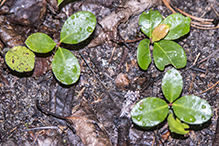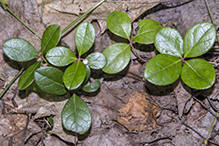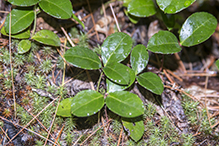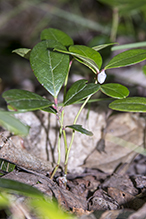wintergreen
(Gaultheria procumbens)
Conservation • Wetland • Description • Habitat • Ecology • Use • Distribution • Taxonomy
Description |
||
Wintergreen is a slow-growing, perennial, evergreen, 2″ to 8″ tall, dwarf shrub. It is common in most of its range from Maine to Minnesota and south along the Appalachian Mountains to Georgia. It is fairly common in northeast and northcentral Minnesota. It grows in dry or moist woodlands, in partial sun or light shade, in nutrient poor, acidic soil. It does not tolerate alkalinity and does not form mats. Ascending branches rise from a creeping, woody, horizontal stem (rhizome). The rhizome may lay on the soil surface or be buried ¾″ to 1¼″ below it. The branches are themselves sparingly branched. They are semi-woody, light green or red, and either covered with white woolly hairs or almost hairless. Two to five leaves are crowded at the end of each branch. The leaves are alternate, evergreen, ¾″ to 1¾″ long, and ⅝″ to 1″ wide. They are on light green or red, 1 ⁄16″ to 3 ⁄16″ long leaf stalks (petioles). The leaf blades are inversely egg-shaped, oval, elliptic, or rarely almost round. They are broadly or narrowly angled at the base and broadly angled or rounded at the tip. The upper surface is bright green or dark green, shiny, and hairless. The lower surface is pale green, hairless, and and covered with a whitish, waxy bloom (glaucous). The margins are slightly rolled backward toward the underside. They have widely-spaced teeth that are tipped with a bristle. The leaves have a minty (wintergreen) fragrance and taste. They turn purplish-red in winter, The inflorescence is two or three flowers, each arising singly from an upper leaf axil. They droop at the end of a pinkish, hairy, 3 ⁄16″ to ⅜″ long flower stalk. The flowers are about 5 ⁄16″ long and urn-shaped to broadly cylinder-shaped. They have have 5 sepals, 5 petals, 10 stamens, and 1 style. The sepals are white and much smaller than the petals. They are fused at their base and for more than half of their length into a saucer-shaped calyx, then separated into 5 lobes at the tip. The petals are white and 5 ⁄16″ to ⅜″ long. They are fused at the base and for almost their entire length, then separated at the tip into 5 very short rounded lobes. The stamens have pinkish stalks (filaments) and yellow forked anthers. After the flower is fertilized, the petals turn brownish and drop off as a unit, leaving the developing fruit and a very long style. When ripe, the fruit is a bright red, ¼″ to ⅜″ in diameter, berry-like capsule that tastes like wintergreen. It has 20 to 80 seeds and often remains on the plant through winter. |
||
Height |
||
2″ to 8″ |
||
Flower Color |
||
White |
||
Similar Species |
||
Habitat |
||
Dry or moist. Forests, woodlands, bogs, and fens. Partial sun or light shade. Acidic soil. |
||
Ecology |
||
Flowering |
||
Mid-June to late August |
||
Pests and Diseases |
||
|
||
Toxicity |
||
Wintergreen contains the aromatic compound methyl salicylate. In the past, oil of wintergreen has been used as a natural flavor in chewing gum, candy, soft drinks, toothpaste, and snuff. Dried leaves have been used to make tea, giving it another common name “teaberry”. In large amounts oil of wintergreen is toxic. Today, methyl salicylate is produced artificially for commercial uses. |
||
Use |
||
|
||
Distribution |
||||
|
Sources |
|||
| 10/26/2021 | ||||
Nativity |
||||
Native |
||||
Occurrence |
||||
Common in northeastern and north-central Minnesota |
||||
Taxonomy |
|||
| Kingdom | Plantae (Plants) | ||
| Division | Tracheophyta (Vascular Plants) | ||
| Subdivision | Spermatophytina (Seed Plants) | ||
| Class | Magnoliopsida (Dicots) | ||
Order |
Ericales (heathers, balsams, primroses, and allies) | ||
Family |
Ericaceae (heath) | ||
| Subfamily | Vaccinioideae (blueberries, cranberries, huckleberries, and allies) | ||
| Tribe | Gaultherieae | ||
Genus |
Gaultheria (snowberry, wintergreen) | ||
Subordinate Taxa |
|||
Synonyms |
|||
Common Names |
|||
American wintergreen checkerberry creeping wintergreen eastern teaberry eastern wintergreen mountain-tea teaberry wintergreen |
|||
Glossary
Calyx
The group of outer floral leaves (sepals) below the petals, occasionally forming a tube.
Filament
On plants: The thread-like stalk of a stamen which supports the anther. On Lepidoptera: One of a pair of long, thin, fleshy extensions extending from the thorax, and sometimes also from the abdomen, of a caterpillar.
Glaucous
Pale green or bluish gray due to a whitish, powdery or waxy film, as on a plum or a grape.
Petiole
On plants: The stalk of a leaf blade or a compound leaf that attaches it to the stem. On ants and wasps: The constricted first one or two segments of the rear part of the body.
Rhizome
A horizontal, usually underground stem. It serves as a reproductive structure, producing roots below and shoots above at the nodes.
Visitor Photos |
|||||
Share your photo of this plant. |
|||||
| This button not working for you? Simply email us at info@MinnesotaSeasons.com. Attach one or more photos and, if you like, a caption. |
|||||
Luciearl |
|||||
 |
|||||
Wintergreen ... a favorite that I look for on walks through the woods. I frequently pick a leaf and tell someone to chew it when on my trail. A pleasant surprise when they bite in. |
 |
||||
 |
|||||
MinnesotaSeasons.com Photos |
|||||
Plants |
|||||
 |
 |
||||
 |
|||||
Flowering Plant |
|||||
 |
 |
||||
 |
|||||
|
|||||
Fruit After the flower is fertilized, the petals turn brownish and drop off as a unit, leaving the developing fruit and a very long style. |
 |
||||
 |
|||||
Leaves |
|||||
 |
 |
||||

Visitor Videos |
|||
Share your video of this plant. |
|||
| This button not working for you? Simply email us at info@MinnesotaSeasons.com. Attach a video, a YouTube link, or a cloud storage link. |
|||
Other Videos |
|||
| Plant portrait - Wintergreen (Gaultheria procumbens) Identify that Plant |
|||
About
Published on Jan 18, 2014 A detailed look at the life cycle of Wintergreen (Gaultheria procumbens). These images can help to accurately identify the plant during different seasons of the year. |
|||
| Gaultheria procumbens VT Dendrology |
|||
About
Published on Apr 22, 2016 teaberry |
|||
| Identifying New England Wintergreen (tea berry) Paleo GreenByrd |
|||
About
Published on Apr 7, 2018 Gaultheria procumbens known as tea berry found in New England, this video is shot in southern Maine |
|||
| American Wintergreen - Gaultheria procumbens - with Susun Weed wisewomantradition |
|||
About
Published on Jun 24, 2017 Susun shows her class American wintergreen. Courtesy of http://www.herbshealing.com -- Join Susun Weed to reweave the healing cloaks of the Ancients. Herbal Medicine is People's Medicine. Learn more at: http://www.wisewomanmentor.com |
|||

Visitor Sightings |
|||||
Report a sighting of this plant. |
|||||
| This button not working for you? Simply email us at info@MinnesotaSeasons.com. Be sure to include a location. |
|||||
| Luciearl 10/25/2021 |
Location: Cass County |
 |
|||
| Luciearl 9/2018 |
Location: Cass County ... a favorite that I look for on walks through the woods. I frequently pick a leaf and tell someone to chew it when on my trail. A pleasant surprise when they bite in. |
 |
|||
| Luciearl 11/2016 |
Location: Cass County |
 |
|||
MinnesotaSeasons.com Sightings |
|||||

11/9/2018
Last Updated:


